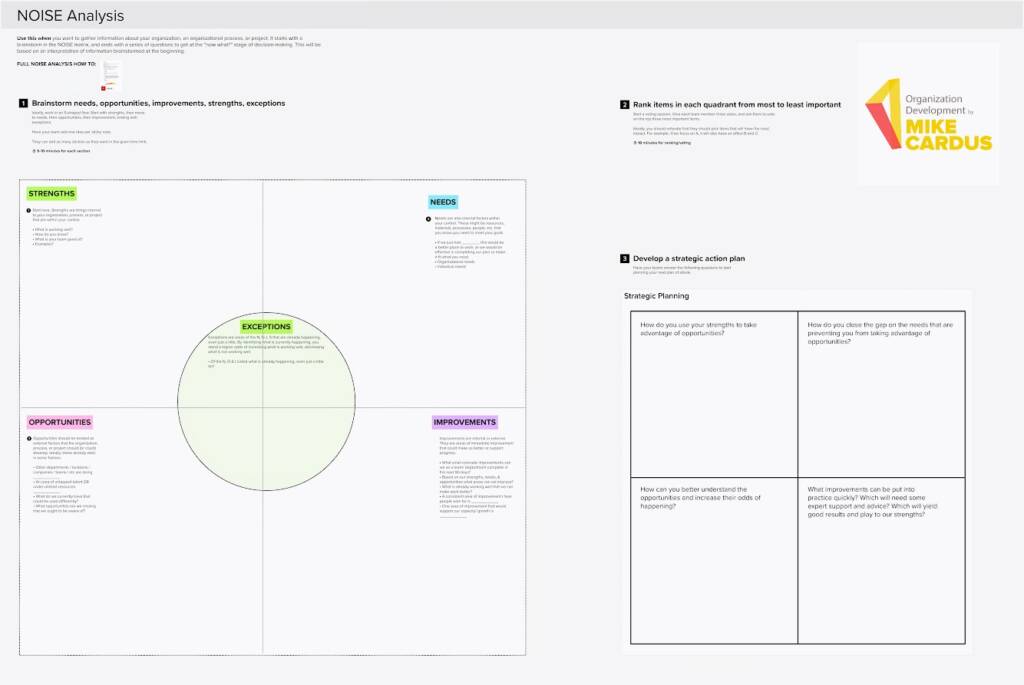I made NOISE Analysis as a strategic-planning solution-focused (problem-solving) framework that can help individuals and teams with some sense-making to understand a situation and identify potential solutions. While it has many benefits, it has its challenges and concerns.
Sometimes I get an email or message about a fault or theoretical error, or someone needs to correct me on how I developed and framed the NOISE analysis.
Here we will examine some of the challenges and problems with NOISE Analysis and explore ways to ease these concerns with similar solution-focused methods.
NOISE analysis is an acronym:
- Needs – what do we need to improve, or what do we need to achieve goals better?
- Opportunities – how do we identify, amplify, or become more aware of what opportunities are present and exist?
- Improvements – What immediate actions or changes will we make with our strengths, needs, and opportunities?
- Strengths – what are we good at, and how do we know?
- Exceptions – Looking at strengths, needs, opportunities, and improvements, what are we already doing (even a little) that we should sharpen and put more energy into?

Challenges and Problems with NOISE Analysis
- Limited Focus on Problem Identification: While NOISE Analysis is designed to help individuals and teams identify potential solutions to a problem, it does not strongly emphasize problem identification. This can be problematic because it can lead to incomplete or inaccurate problem identification, which can hinder the development of practical solutions.
- Lack of Clarity: NOISE Analysis can be vague and open-ended. Knowing when to stop asking questions and move on to the next step can be challenging. This can lead to a lack of clarity and direction, which is frustrating for individuals or teams trying to solve a problem.
- Time-Consuming: NOISE Analysis can be a time-consuming process. Answering questions about each NOISE element can take considerable time, especially if the situation being analyzed is complex. This can challenge individuals or teams needing to identify and implement solutions quickly.
- Potential for Bias: NOISE Analysis is a subjective process that personal biases and perspectives can influence. This can lead to incomplete or inaccurate analysis and solutions that may need to address the problem more effectively.
- Limited Focus on Action Planning: While NOISE Analysis is designed to identify potential solutions, it needs to provide a stronger framework for action planning. This can be problematic because it can make implementing solutions and monitoring progress challenging.
Ways to Ease Concerns with Similar Solution-Focused Methods
- Incorporate Problem Identification Frameworks: Individuals or teams can incorporate problem identification frameworks such as the Five Whats and How or Fishbone Diagrams into the NOISE Analysis process to address the limited focus on the problem identification challenge. These frameworks can help individuals or teams identify the potential causes of the problem and develop effective solution statements.
- Provide Guidelines: To address the need for more clarity, individuals or teams can provide clear guidelines for each step of the NOISE Analysis process. This can include specific questions to ask, criteria for moving on to the next step, and clear timelines for completing each step.
- Use Time-Management Strategies: To address the challenge of time-consuming analysis, individuals or teams can use time-management strategies such as prioritizing questions and breaking down the analysis into smaller, more manageable steps. This can help ensure that the analysis is completed efficiently and effectively.
- Use Agreed-on Criteria: Individuals or teams can use criteria and data to guide the analysis and solution development to address the potential for bias. This can help ensure that the solutions developed are based on interactional information and biases are seen and have a chance to be considered and acknowledged as part of the process.
- Incorporate Action Planning Frameworks: Individuals or teams can incorporate action planning frameworks such as the SLVR matrix or Action Planning Worksheets into the NOISE Analysis process to address the action planning. These frameworks can help individuals or teams develop specific and measurable goals, and action plans to implement solutions and monitor progress.
NOISE Analysis is a valuable tool for problem-solving and solution development. However, it has its challenges and problems. By incorporating problem identification frameworks, providing clear guidelines, using time-management strategies, using agreed-upon criteria, and incorporating action planning frameworks, individuals or teams can ease concerns with NOISE Analysis and develop more effective solutions.


